仁爱版英语七年级上册Unit3-Topic1-SectionA精品课件
- 格式:ppt
- 大小:2.95 MB
- 文档页数:67
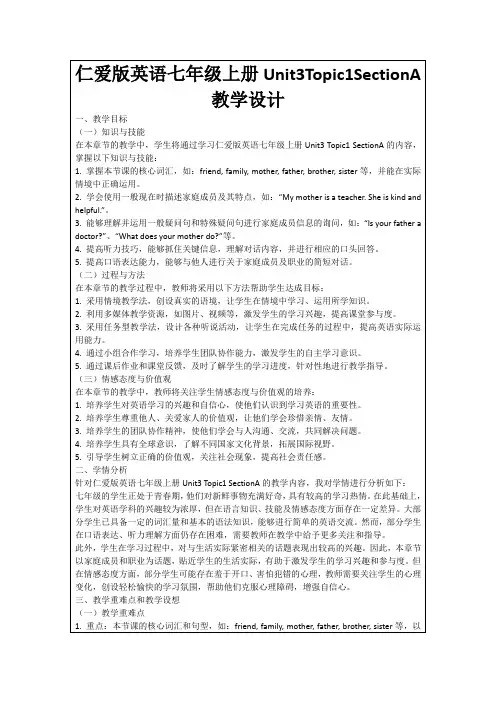
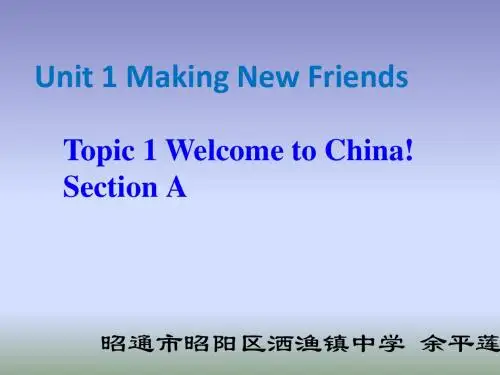
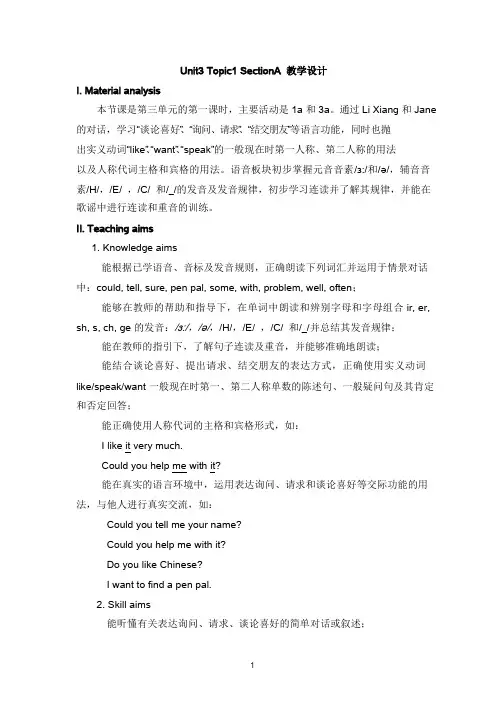
Unit3 Topic1 SectionA 教学设计Ⅰ. Material analysis本节课是第三单元的第一课时,主要活动是1a 和3a。
通过Li Xiang 和Jane 的对话,学习“谈论喜好”、“询问、请求”、“结交朋友”等语言功能,同时也抛出实义动词“like”、“want”、“speak”的一般现在时第一人称、第二人称的用法以及人称代词主格和宾格的用法。
语音板块初步掌握元音音素/з:/和/ə/,辅音音素/H/,/E/ ,/C/ 和/_/的发音及发音规律,初步学习连读并了解其规律,并能在歌谣中进行连读和重音的训练。
Ⅱ.Teaching aims1. Knowledge aims能根据已学语音、音标及发音规则,正确朗读下列词汇并运用于情景对话中:could, tell, sure, pen pal, some, with, problem, well, often;能够在教师的帮助和指导下,在单词中朗读和辨别字母和字母组合ir, er, sh, s, ch, ge 的发音:/з:/,/ə/,/H/,/E/ ,/C/ 和/_/并总结其发音规律;能在教师的指引下,了解句子连读及重音,并能够准确地朗读;能结合谈论喜好、提出请求、结交朋友的表达方式,正确使用实义动词like/speak/want 一般现在时第一、第二人称单数的陈述句、一般疑问句及其肯定和否定回答;能正确使用人称代词的主格和宾格形式,如:I like it very much.Could you help me with it?能在真实的语言环境中,运用表达询问、请求和谈论喜好等交际功能的用法,与他人进行真实交流,如:Could you tell me your name?Could you help me with it?Do you like Chinese?I want to find a pen pal.2. Skill aims能听懂有关表达询问、请求、谈论喜好的简单对话或叙述;1能就表达询问、请求、谈论喜好等的话题进行交流;能正确地朗读对话,注意重音和连读;能写出表达询问、请求和谈论喜好的简单句子或者小短文。
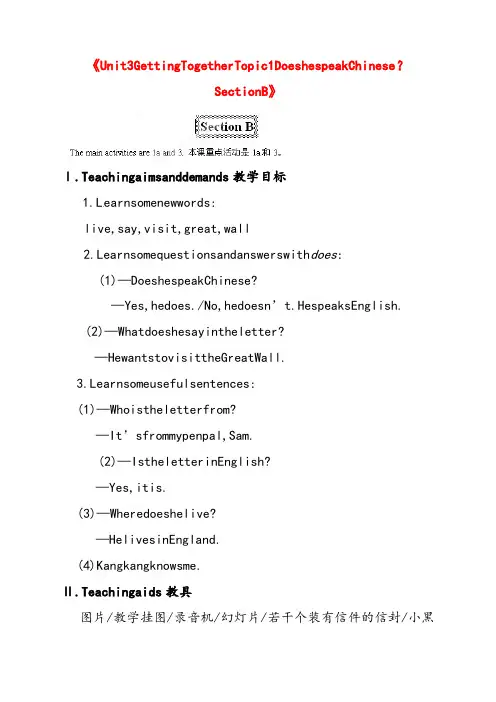
《Unit3GettingTogetherTopic1DoeshespeakChinese?SectionB》Ⅰ.Teachingaimsanddemands教学目标1.Learnsomenewwords:live,say,visit,great,wall2.Learnsomequestionsandanswerswith does:(1)—DoeshespeakChinese?—Yes,hedoes./No,hedoesn’t.HespeaksEnglish.(2)—Whatdoeshesayintheletter?—HewantstovisittheGreatWall.3.Learnsomeusefulsentences:(1)—Whoistheletterfrom?—It’sfrommypenpal,Sam.(2)—IstheletterinEnglish?—Yes,itis.(3)—Wheredoeshelive?—HelivesinEngland.(4)Kangkangknowsme.Ⅱ.Teachingaids教具图片/教学挂图/录音机/幻灯片/若干个装有信件的信封/小黑板Ⅲ.Five-fingerTeachingPlan五指教学方案Step1Review第一步复习(时间:10分钟)以问题为线索,引出单词和话题,培养学生的语言表达能力。
1.(检查作业。
教师请学生登台表演上节课的家庭作业。
)T:Now,I’llcheckyourhomework.S1、S2,please,cometothefrontandperformyourdialog.2.(师生对话。
引入并运用China和Chinese。
)T:IcomefromChina.IamChinese.Ss:WecomefromChina.We’reChinese.(教师提问一名学生。
)T: Wheredoyoucomefrom,S3?S3:IcomefromChina.T: DoyouspeakChinese?S3:Yes,Ido.(学生两人一组互相问答。

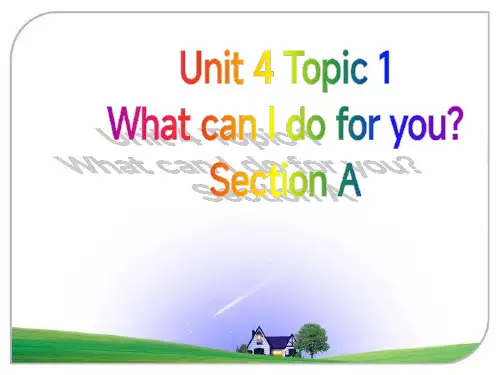
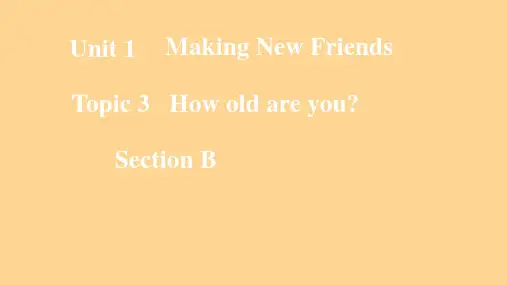
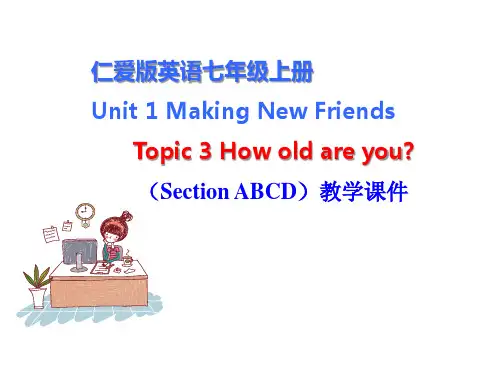
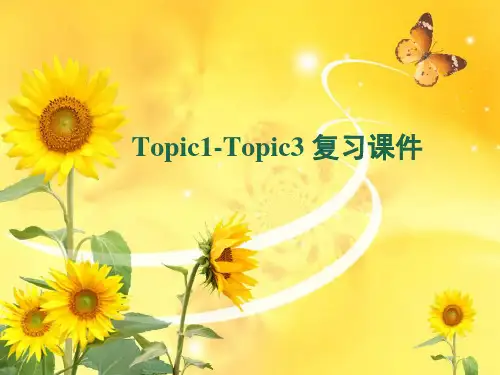
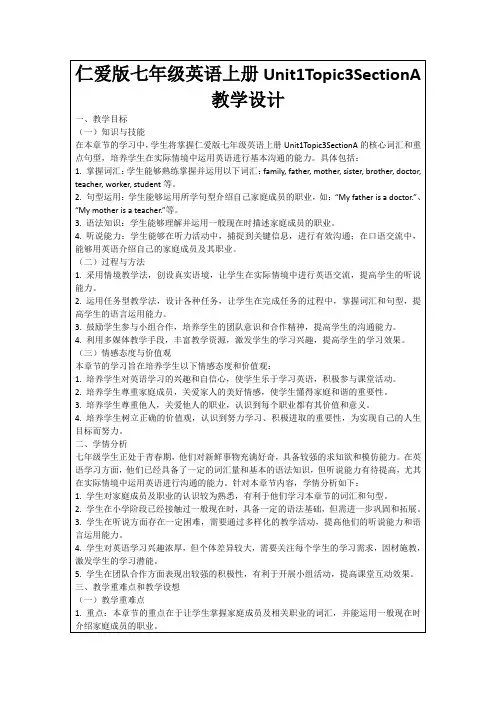
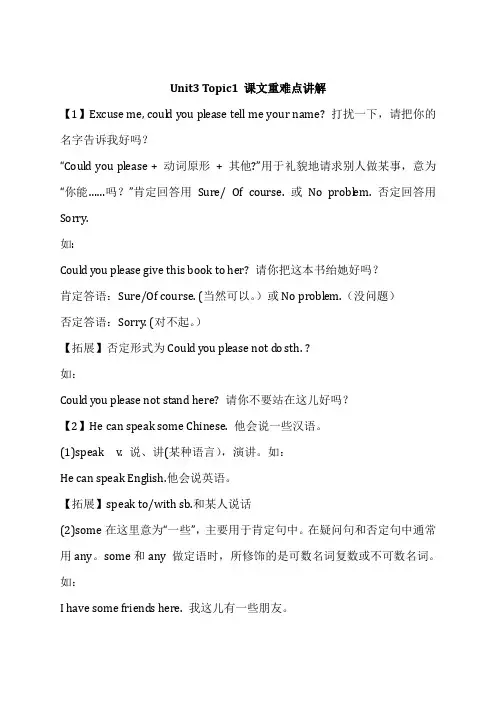
Unit3 Topic1 课文重难点讲解【1】Excuse me, could you please tell me your name? 打扰一下,请把你的名字告诉我好吗?“Could you pl ease + 动词原形+ 其他?”用于礼貌地请求别人做某事,意为“你能……吗?”肯定回答用Sure/ Of course. 或No problem. 否定回答用Sorry.如:Could you please give this book to her? 请你把这本书绐她好吗?肯定答语:Sure/Of course. (当然可以。
)或No problem.(没问题)否定答语:Sorry. (对不起。
)【拓展】否定形式为Could you please not do sth. ?如:Could you please not stand here? 请你不要站在这儿好吗?【2】He can speak some Chinese. 他会说一些汉语。
(1)speak v. 说、讲(某种语言),演讲。
如:He can speak English.他会说英语。
【拓展】speak to/with sb.和某人说话(2)some在这里意为“一些”,主要用于肯定句中。
在疑问句和否定句中通常用any。
some和any 做定语时,所修饰的是可数名词复数或不可数名词。
如:I have some friends here. 我这儿有一些朋友。
They don’t have any English books. 他们没有英语书。
Do you have any pencils? 你有铅笔吗?【3】—Do you like Chinese?你喜欢汉语吗?—Yes, I do. 是的,我喜欢。
(1)当句中有实义动词时,要用助动词d o或does构成疑问句,且实义动词用原形。
does用于第三人称单数,do用于其他人称。
其句型结构:Do/ Does +主语+动词原形+……?肯定回答为Yes,… do/does. 否定回答为No, …don’t/d oesn’t.如:—Do you like eats? 你喜欢猫吗?—Yes, I do. 是的,我喜欢。
Unit1 Topic3 Section A参考教案The main activities are 1, 2 and 4a. 本课重点活动是1,2和4a。
Ⅰ. Teaching aims and demands教学目标1. (1)Learn some numeral words:eleven, twelve, thirteen, fourteen, fifteen, sixteen, seventeen, eighteen, nineteen,twenty(2)Learn other useful words and expressions:old, How old...,phone, in, grade, who, that2. Master the special questions:(1)Who’s that?That’s Nancy.(2)What class are you in?I’m in Class Four, Grade Seven.3. Talk about school life:(1)What grade are you in?I’m in Grade Seven.(2)What class is she in?She’s in Class Eleven, Grade Eight.Ⅱ. Teaching aids教具明星照片/ 数字卡片/音频设备/ 学生照片Ⅲ. Five-finger Teaching Plan五指教学方案Step 1 Review 第一步温习(时间:7分钟)1. (1)T: Let’s play a game.(做下面的游戏,温习数字1~10。
)教师向学生演示游戏规则:一名同窗开始从one报数,其他学生按顺时针方向依次快速用英语报数。
每逢五或五的倍数时,报数的学生不能说出该数,只是站起来后又坐下,然后下一个学生接着说下一个数。
例如:第一个学生:one第二个学生:two第三个学生:three第四个学生:four第五个学生:(站起后迅速坐下)第六个学生:six第七个学生:…出现失误的学生当即退出活动,下一名同窗从one开始从头报数,坚持到最后4~6名学生可评为优胜者并给予奖励。
Unit 3 Getting TogetherTopic 1 Does he speak Chinese?教学内容分析及课时分配建议:该话题主要围绕有关认识朋友、谈论喜好等话题展开。
此话题贴近学生实际生活,可以让学生感受到英语在生活中的实践意义,从而提高他们学习英语的积极性。
本话题主要包括三个部分:Li Xiang 和Jane 交朋友并谈论喜好,Jane 和Kangkang谈论笔友,介绍Jane, Sally 和“我” 在学习上互相帮助。
在此过程中学习如何表达询问、请求以及谈论个人喜好等;主要句型和语法是“Could you…?,” “ Does he/she like…?”, “He /She likes …a little/ very much/a lot.”,以及实义动词want/like/speak 的第三人称单数一般现在时的陈述句、一般疑问句及其肯定句和否定句的回答;最后通过project的活动,综合本单元所学,使语言知识学以致用。
本话题建议用5个课时来完成:第一课时:Section A 1a, 1b, 1c, 1d, 2, 3a第二课时:Section B 1a, 1b, 1c, 1d Section A 3b, 4第三课时:Section B 2a, 2b, 3 Section C 4a, 4b第四课时:Section C1a, 1b, 2a, 2b, 3第五课时:Section D Grammar& Functions, 1, 2, Project第四课时(Section C1a, 1b, 2a, 2b, 3)教学设计思路:本课的短文通过介绍“我”的两个同学,进一步学习表示喜好的表达法。
首先通过头脑风暴的方式复习了第三人称单数的一般现在时,为本课学习做铺垫。
通过引入学生喜欢的明星导入本课的重难点,即like…a little, like…a lot/very much, doesn’t like at all.然后让学生结合实际生活,谈论对英语和语文学科的喜好,及时进行复习巩固,同时也训练学生将图表信息转化为口头表达的能力。
仁爱七上-Unit3 Topic1知识梳理【重点短语和句型】1. Could you please + 动词原形……?用来表示委婉的请求---Could you please tell me your name?--- Sure/ No problem. My name is Sally.--- Sorry.2. tell sb. sth. = tell sth. to sb. 告诉某人某事tell sb. about sth. 告诉某人关于某事Please tell me your name. = Please tell your name to me.Please tell Maria about it. 请把这件事告诉玛丽亚吧。
3. help sb. do sth.= help sb. with sth. 在某方面帮助某人,帮助某人做某事Please help us find him.Could you please help me with English?= Could you please help me study English?4. want to do sth.= would like to do sth. 想要做某事want sth. = would like sth. 想要某物want sb. to do sth. 想要某人做……He wants to visit Beijing. = He would like to visit Beijing.I want/would like an orange.Jane wants Kangkang to sing some songs with her.5. show sth. to sb.= show sb. sth. 把某物展示给某人看Maria shows a photo of her family to Kangkang.6. My English is very good. =I can speak English very well.7. live in+ 地点居住在某地live with + sb. 和某人住He live in China with his parents.8. know a lot ab out…… 知道许多关于……的事He knows a lot about China.9. say表示说话的内容,speak表示说某种语言的能力What does he say in the letter?He can speak some English.10.对事物的喜欢程度like……very much/a lot 非常喜欢like……a little 有点喜欢don’t like……at all 一点都不喜欢Many students in our class like English a lot, but I like it a little.He doesn’t like chocolate at all.11. a lot of+可数名词复数/不可数名词I have a lot of English books.12. every day 每天each other 相互some of them 他们中的一些eat out 下馆子,到外面吃饭13. play with sb. 和某人一块玩耍like to do/doing sth. 喜欢(做)某事She likes to play with Kitty.14. Help yourself/yourselves to sth. 随便吃(喝)……15. be kind to sb. 对某人很友好They are all kind to me. 他们对我很友好。
Unit 3 Topic 1一.重点单词(所有学生都需掌握)△can(modal v..)——could(过去式)well(adv./adj.)——good(adj.)pen pal(n.)——penfriend(同义词)many(pron.+可数名词复数)——much(pron.+不可数名词)二.词组(所有学生都需掌握)Section Ae from= be from 来自于…2.help sb. with sth.= help sb. do sth. 帮肋某人做某事3.help me with my Chinese 帮助我学汉语4.no problem. 没问题5.speak Chinese / English very well 汉语/英语说得很好Section B1.know a lot about sth. 对某事很了解; 对某事知道得很多2.live in 居住在….3.in the letter 在信中4.want to do sth. 想要做某事5.visit Beijing 参观北京Section C1.like...a lot/very much 非常喜欢2.like...a little 有点喜欢3.help each other 互相帮助4.not…at all 一点也不; 根本不Section D1. a lot of+名词复数/不可数名词许多=many +名词复数/ much+不可数名词2. a lot of people 许多人3.every day 每天4.pen pal=penfriend 笔友5.read books 看书三.重点句子(所有学生都需掌握)Section A1.Excuse me, Could you please tell me your name? Sure打扰一下,你可以告诉我你的名字吗?当然可以①在向陌生人咨询或打扰别人的情况下,我们一般先说Excuse me;因做错事而向某人道歉时才用Sorry。